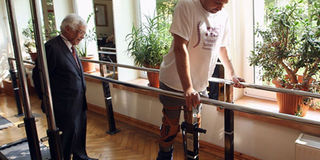Paralysed man walks again after breakthrough nerve treatment

Professor Wagih el-Masri (left), a surgeon and founder of spinal injury charity SPIRIT, watches as Bulgarian man Darek Fidyka walks with the aid of leg-braces and parallel bars at the Akron Neuro-Rehabilitation Center in Wroclaw, Poland, after receiving revolutionary treatment to repair a severed spinal column that rendered him paralysed from the chest down. FILE PHOTO | AFP
What you need to know:
- Darek Fidyka was paralysed from the chest down, but can now walk using a frame after nerve cells from his nose were transplanted into his severed spinal column in Poland.
- Olfactory ensheathing cells (OECs), which form part of the sense of smell, were used in the treatment as they are pathway cells that enable nearby nerve fibres to be regenerated.
LONDON
A paralysed man can walk again after receiving revolutionary treatment which one of the British scientists responsible hailed as a breakthrough “more impressive than a man walking on the Moon” — although others urged caution.
Darek Fidyka was paralysed from the chest down, but can now walk using a frame after nerve cells from his nose were transplanted into his severed spinal column in Poland, according to research published Tuesday in the journal Cell Transplantation.
“When there’s nothing, you can’t feel almost half of your body. You’re helpless, lost,” the patient, who is now recovering at the Akron Neuro-Rehabilitation Centre in Wroclaw, told the BBC’s Panorama programme, who filmed his remarkable recovery. “When it (the feeling) begins to come back, you feel you’ve started your life all over again, as if you are reborn,” said the 40-year-old Polish man living in Poland, whose injuries were caused by a knife attack in 2010.
“It’s an incredible feeling, difficult to describe,” he added.
Olfactory ensheathing cells (OECs), which form part of the sense of smell, were used in the treatment as they are pathway cells that enable nearby nerve fibres to be regenerated.
Pawel Tabakow, consultant neurosurgeon at Wroclaw University, led a team of surgeons in removing one of the patient’s olfactory bulbs before transplanting cultured cells into the spinal cord in the treatment’s two crucial operations.
TOO EARLY TO TELL
Contacted by AFP, he said the patient was “exhausted” by the documentary filming schedule, which lasted a year.
The head of neurosurgery at the Polish clinic, Wlodzimierz Jamundowicz, said in a statement it was too early to tell whether the treatment could be successful on other patients.
“This is only the beginning of a long and difficult journey,” he said.
The scientists involved think that the cells, implanted above and below the injury, enabled damaged fibres to reconnect, although other researchers have reacted more sceptically.
“What we’ve done is establish a principle — nerve fibres can grow back and restore function, provided we give them a bridge,” said Geoff Raisman, chair of neural regeneration at University College London’s Institute of Neurology, who led the British research team working on the joint project.





